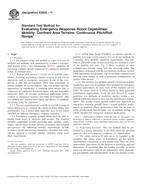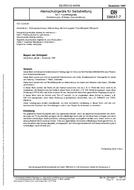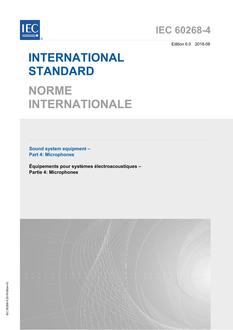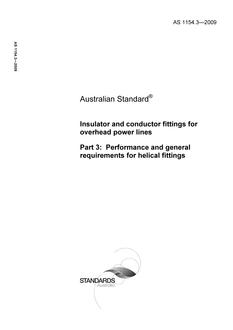ASTM E2826-11 PDF
$36.00
Standard Test Method for Evaluating Emergency Response Robot Capabilities: Mobility: Confined Area Terrains: Continuous Pitch/Roll Ramps
standard by ASTM International, 07/01/2011
Description
1.1 Purpose:
1.1.1 The purpose of this test method, as a part of a suite of mobility test methods, is to quantitatively evaluate a teleoperated ground robot's (see Terminology E2521) capability of traversing complex terrain composed of continuous pitch/roll ramps in confined areas.
1.1.2 Robots shall possess a certain set of mobility capabilities, including negotiating complex terrains, to suit critical operations such as emergency responses. A part of the complexity is that the environments often pose constraints to robotic mobility to various degrees. This test method specifies apparatuses to standardize a confined areas terrain that is composed of continuous pitch/roll ramps and that notionally represents types of terrains containing undulating slopes, existent in emergency response and other environments. This test method also specifies procedures and metrics to standardize testing using the apparatus.
1.1.3 The test apparatuses are scalable to provide a range of lateral dimensions to constrain the robotic mobility during task performance. Fig. 1 shows three apparatus sizes to test robots intended for different emergency response scenarios.
1.1.4 Emergency response ground robots shall be able to handle many types of obstacles and terrains. The required mobility capabilities include traversing gaps, hurdles, stairs, slopes, various types of floor surfaces or terrains, and confined passageways. Yet additional mobility requirements include sustained speeds and towing capabilities. Standard test methods are required to evaluate whether candidate robots meet these requirements.
1.1.5 ASTM Task Group E54.08.01 on robotics specifies a mobility test suite, which consists of a set of test methods for evaluating these mobility capability requirements. This continuous pitch/roll ramps terrain traversing test method is a part of the mobility test suite. Fig. 2 shows examples of other confined area terrains, along with the traversing paths. The apparatuses associated with the test methods challenge specific robot capabilities in repeatable ways to facilitate comparison of different robot models as well as particular configurations of similar robot models.
1.1.6 The mobility test methods quantify elemental mobility capabilities necessary for ground robot intended for emergency response applications. As such, users of this standard can use either the entire suite or a subset based on their particular performance requirements. Users are also allowed to weight particular test methods or particular metrics within a test method differently based on their specific performance requirements. The testing results should collectively represent an emergency response ground robot's overall mobility performance as required. These performance data can be used to guide procurement specifications and acceptance testing for robots intended for emergency response applications.
Note 1 – Additional test methods within the suite are anticipated to be developed to address additional or advanced robotic mobility capability requirements, including newly identified requirements and even for new application domains.
1.2 Performing Location – This test method shall be performed in a testing laboratory or the field where the specified apparatus and environmental conditions are implemented.
1.3 The values stated in SI units are to be regarded as the standard. The values given in parentheses are not precise mathematical conversions to inch-pound units. They are close approximate equivalents for the purpose of specifying material dimensions or quantities that are readily available to avoid excessive fabrication costs of test apparatuses while maintaining repeatability and reproducibility of the test method results. These values given in parentheses are provided for information only and are not considered standard.
1.4 This standard does not purport to address all of the safety concerns, if any, associated with its use. It is the responsibility of the user of this standard to establish appropriate safety and health practices and determine the applicability of regulatory limitations prior to use.

FIG. 1 Mobility: Confined Area Terrains: Continuous Pitch/Roll Ramps Apparatuses

FIG. 2 Three Confined Area Terrain Apparatuses in the Mobility Test Suite with Increasing Complexity; The Continuous Pitch/Roll Ramps Terrain is Shown on the Left. The Crossing Pitch/Roll Ramps is Shown at the Center. The Symmetric Stepfields Terrain is Shown on the Right.
Product Details
- Published:
- 07/01/2011
- Number of Pages:
- 10
- File Size:
- 1 file , 590 KB
- Note:
- This product is unavailable in Russia, Ukraine, Belarus





